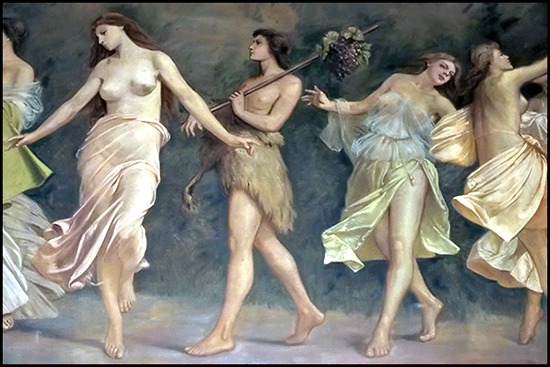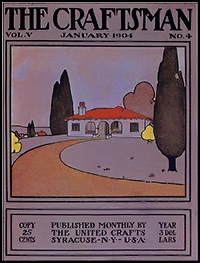



Although heavily occupied with his Ray Memorial Library commission at Franklin, Massachusetts, Juglaris was well aware of the mural work still underway at the Boston Public Library in Copley Square. Reflecting a somewhat competitive spirit, he confided in his memoir: “[At] the Boston Library there were decorations by Puvis de Chavannes, by Sargent, by Chase [sic] and others, but . . . I must do better, especially more pleasing decorations.” In this, Juglaris succeeded. As reported in Boston newspapers, his preliminary drawings for the Franklin Public Library Reading Room created “a big stir” when exhibited at the Massachusetts Institute of Technology. Likewise, his completed friezes and murals drew fulsome praise from art critics Margaret Storrs Turner and Irene Sargent, respectively writing on behalf of The New England Magazine and Gustave Stickley’s The Craftsman.
Describing the Franklin Library Reading Room as “already famous for the decoration of its walls,” Margaret Storrs Turner, who wrote frequently on art and cultural topics for New England Magazine, remarked: “There is nothing sentimental, mystic here. The clear joyousness of the pictures fit the building as glove fits hand. The serenity of the classic form pervades the whole design. The gaiety of youth, the dignity of age are imbued alike with the spirit of the antique, (with) a glad freshness of color which is part and parcel of the cunningly devised whole.”

Irene Sargent was an internationally renowned art and architectural critic who became an important spokesman for the Arts and Crafts Movement and, along with Gustav Stickley, helped launch The Craftsman as a leading journal of the day. She commended Juglaris for his “free, assured manner” and colors that “sing as they go, and through them, the procession seems to acquire the real motion it simulates.” Skeptical of the aesthetic tastes and judgment of most Italian artists then at work in the early twentieth century, Sargent considered Juglaris exceptional: “[T]he painting of Mr. Juglaris shows a comprehension of the antique spirit unusual in a man of our time . . . [He] is a trained enthusiast possessed of a distinction and of qualities rarely found among Italians, whose traditions and surroundings have fostered imitation and smothered originality. Showing no traits of a copyist, Mr. Juglaris belongs to a comparatively small number of his compatriots who have really assimilated the principles of classic art and have used them to their own delight, in the spirit of Michelangelo, when, in his blind old age, he was led daily to the colossal torso of the Hercules, that he might follow with his hands the lines of its superb muscular development.”
In admiring Juglaris’s mural work, Sargent took a veiled swipe at other current American mural work for being excessively complex and overwrought. As Sargent notes: “Altogether the decoration [at the Franklin Public Library] as to its use of color, besides possessing remarkable intrinsic beauty, is valuable as showing a return to old principles, rather than the evolution and complexity so evident in the work of American mural decorations. It cannot fail to recall that small exquisite fragment of antique fresco, practically hidden in the Vatican Library, and known under the name of the 'Aldobrandini Marriage.' From this, ‘the pale ghost of a beautiful work,’ the Juglaris painting would seem to have been incarnated and intensified: inspired with the color which is the requisite and life of modern art. The Italian of to-day [i.e., Juglaris], in this important decoration, has given proof that the classic principles are not yet exhausted and effete; that they constitute the foundation of all thorough art study, just as the Greek and Latin languages must continue to form the basis of all literary culture.”
Both the New England Magazine and The Craftsman articles offered high praise for Juglaris in an increasingly nationalistic era when there was generally more enthusiasm for native-born artists and muralists, as well as the kind of patriotic themes represented in the historical paintings of Juglaris’s past friend and colleague John Ward Dunsmore and the popular flag paintings of his student, Childe Hassam.